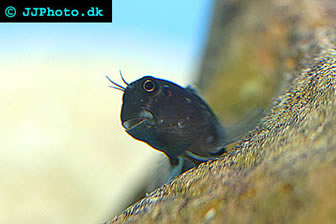Bicolor Blenny
Ecsenius bicolor
Ecsenius bicolor is a popular aquarium fish that hails from coral reefs in the Indian and Pacific Oceans. It is often referred to as Bicolour Blenny, but the two-coloured variant is only one of three different known colour variants.
Variant 1: The anterior part of the fish is deep blue while the posterior part is bright orange.
Variant 2: The entire body is dark brown.
Variant 3: The body is decorated with a complex pattern. One black and one white line runs horizontally across the body.
All three colour forms display a curved pinkish marking behind the eye. The guidelines provided in this article are true for all members of the species Ecsenius bicolour, not only for the two coloured variant.
Ecsenius bicolour belongs to the family Blenniidae, the Combtooth blennies. It was once considered a member of the genus Salarias and if you are looking for information about this species in older sources you might find it under the name Salarias bicolor, Salarias burmanicus, Salarias furcatus or Salarias melanosoma. Within the genus Ecsenius, it has been known as Ecsenius hawaiiensis.
Ecsenius bicolour has not been evaluated for the IUCN Red List of Threatened Species.
Keeping Bicolour Blenny in aquariums
As mentioned above, Ecsenius bicolour is a popular aquarium fish among saltwater aquarists and it is considered quite hardy. It can reach a maximal size of 11 cm / 4.3 in and this must naturally be taken into account when it comes to aquarium size. The species is friendly and can be kept with other peaceful fishes of roughly the same size. Successfully keeping several Ecsenius bicolour together can be tricky, especially if the aquarium is rather small and not very cleverly decorated. Use a secure lid on your aquarium, because this fish can jump surprisingly high.
In the wild, the Bicolor Blenny will hide in cracks and crevices in the coral reef and it is therefore important to provide it with similar hiding spots in the aquarium. Without suitable places to seek shelter, the Bicolor Blenny will feel stressed and become more susceptible to disease. The Bicolor Blenny is often kept in reef aquariums, but it is important to keep in mind that it likes to nibble on corals and mussels. The Bicolour Blenny enjoys digging and substrate with sharp edges must therefore be avoided in the aquarium. The recommended water temperature is 24-29° C / 75-85° F.
Feeding Bicolor Blenny
In the wild, the Bicolour Blenny feed chiefly on algae and plant material. In the aquarium, it will readily accept most types of vegetable food. It is important to provide it with a varied diet. You can for instance combine fresh, frozen and dried foods. Vegetables are known to be appreciated and beneficial, but the fish should ideally also be fed some type of food that contains marine and blue-green algae. If you don’t keep your Bicolour Blenny well fed, it might attack invertebrates in the aquarium.
Breeding Bicolor Blenny
The Bicolour Blenny is an egg-laying species. The eggs are adhesive and can be found on or near the bottom.
Blenny articles
Highfin Blenny – A guide to caring for Atrosalarias fuscus
Midas Blenny – A guide to caring for Ecsenius midas
Redspotted Rockskipper – A guide to caring for Istiblennius chrysospilos
Redlip Blenny – A guide to caring for Ophioblennius atlanticus
Lawnmower Blenny – A guide to caring for Salarias fasciatus

